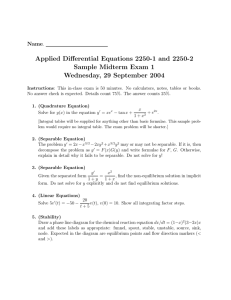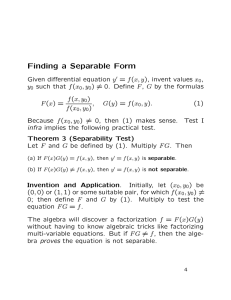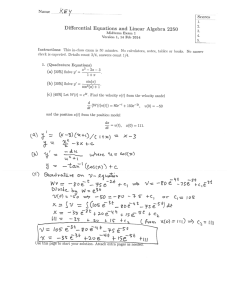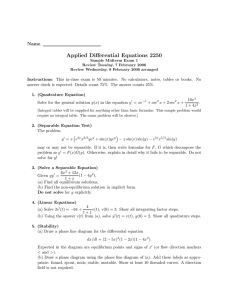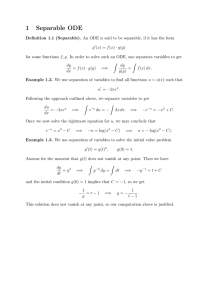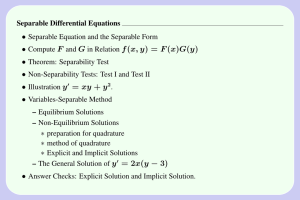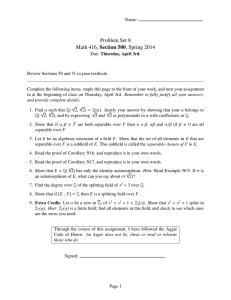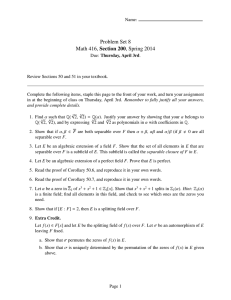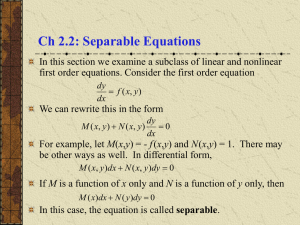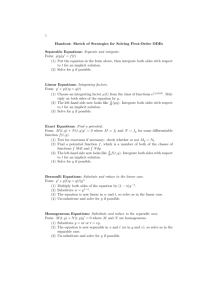•
advertisement
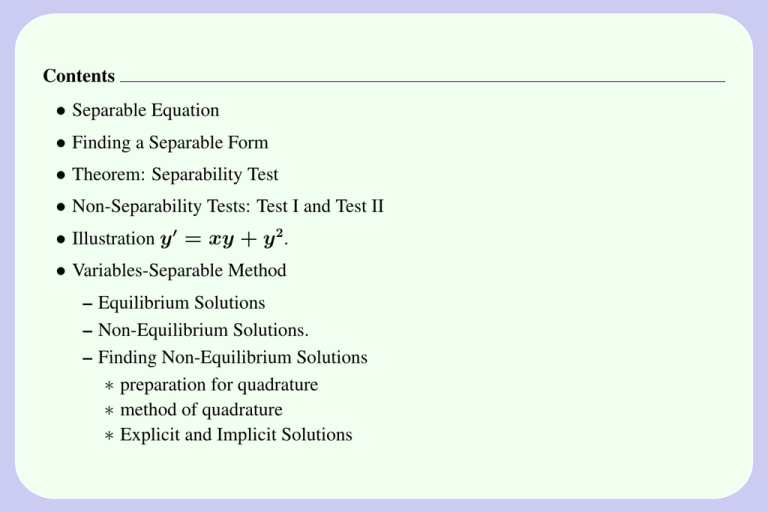
Contents
• Separable Equation
• Finding a Separable Form
• Theorem: Separability Test
• Non-Separability Tests: Test I and Test II
• Illustration y 0 = xy + y 2.
• Variables-Separable Method
– Equilibrium Solutions
– Non-Equilibrium Solutions.
– Finding Non-Equilibrium Solutions
∗ preparation for quadrature
∗ method of quadrature
∗ Explicit and Implicit Solutions
Definition (Separable Equation). An equation y 0 = f (x, y) is called separable provided there exists functions F (x) and G(y) such that
f (x, y) = F (x)G(y).
Definition (Separated Form of a Separable Equation). This is the equation
y 0/G(y) = F (x).
It is obtained from the separable equation y 0 = F (x)G(y) by dividing by G(y).
Such an equation is said to be prepared for quadrature, because the LHS is independent of
x and the RHS is independent of y .
Finding a Separable Form
Given differential equation y 0 = f (x, y), invent values x0 , y0 such that f (x0 , y0 ) 6=
0. Define F , G by the formulas
(1)
F (x) =
f (x, y0)
f (x0, y0)
,
G(y) = f (x0, y).
Because f (x0 , y0 ) 6= 0, then (1) makes sense. Test I infra implies the following test.
Theorem 1 (Separability Test)
Let F and G be defined by (1). Multiply F G. Then
(a) If F (x)G(y) = f (x, y), then y 0 = f (x, y) is separable.
(b) If F (x)G(y) 6= f (x, y), then y 0 = f (x, y) is not separable.
Invention and Application
Initially, let (x0 , y0 ) be (0, 0) or (1, 1) or some suitable pair, for which f (x0 , y0 ) 6= 0;
then define F and G by (1). Multiply to test the equation F G = f .
The algebra will discover a factorization f = F (x)G(y) without having to know algebraic tricks like factorizing multi-variable equations. But if F G 6= f , then the algebra
proves the equation is not separable.
Non-Separability Tests
Test I. Equation y 0 = f (x, y) is not separable provided for some pair of points (x0 , y0 ),
(x, y) in the domain of f , (2) holds:
f (x, y0)f (x0, y) − f (x0, y0)f (x, y) 6= 0.
(2)
Test II. The equation y 0 = f (x, y) is not separable if either of the following conditions
hold:
• fx(x, y)/f (x, y) is non-constant in y
or
• fy (x, y)/f (x, y) is non-constant in x.
Test I details
Assume f (x, y) = F (x)G(y), then equation (2) fails because each term on the
left side of (2) equals F (x)G(y0 )F (x0 )G(y) for all choices of (x0 , y0 ) and (x, y)
(hence contradiction 0 6= 0).
Test II details
Assume f (x, y) = F (x)G(y) and suppose F , G are sufficiently differentiable. Then
•
fx(x, y)
f (x, y)
=
F 0(x)
F (x)
is independent of y
and
•
fy (x, y)
f (x, y)
=
G0(y)
G(y)
is independent of x.
Illustration
Consider y 0 = xy + y 2 .
Test I implies it is not separable, because the left side of the relation is
LHS = f (x, 1)f (0, y) − f (0, 1)f (x, y)
= (x + 1)y 2 − (xy + y 2)
= x(y 2 − y)
6= 0.
Test II implies it is not separable, because
fx
f
is not constant as a function of y .
=
1
x+y
Variables-Separable Method
The method determines two kinds of solution formulas.
Equilibrium Solutions.
They are the constant solutions y = c of y 0 = f (x, y). For any equation, find them by
substituting y = c into the differential equation.
Non-Equilibrium Solutions.
For a separable equation
y 0 = F (x)G(y),
a non-equilibrium solution y is a solution with G(y) 6= 0. It is found by dividing by
G(y), then applying the method of quadrature.
Theory of Non-Equilibrium Solutions
A given solution y(x) satisfying G(y(x)) 6= 0 throughout its domain of definition is
called a non-equilibrium solution. Then division by G(y(x)) is allowed.
The method of quadrature applies to the separated equation y 0 /G(y(x)) = F (x).
Some details:
R x y 0(t)dt
x0
G(y(t))
R y(x) du
y0
G(u)
y(x) = W
=
=
−1
Rx
x0
Rx
x0
R
F (t)dt
F (t)dt
x
x0
F (t)dt
Integrate both sides of the separated equation over x0 ≤ t ≤ x.
Apply on the left the change of variables u =
y(t). Define y0 = y(x0).
Ry
Define W (y) = y0 du/G(u). Take inverses to isolate y(x).
In practise, the last step with W −1 is never done. The preceding formula is called the
implicit solution. Some work is done to find algebraically an explicit solution, as is given
by W −1 .
Explicit and Implicit Solutions
Definition 1 (Explicit Solution)
A solution of y 0 = f (x, y) is called explicit provided it is given by an equation
y = an expression independent of y.
To elaborate, on the left side must appear exactly the symbol y followed by an equal sign.
Symbols y and = are followed by an expression which does not contain the symbol y .
Definition 2 (Implicit Solution)
A solution of y 0 = f (x, y) is called implicit provided it is not explicit.
Examples
• Explicit solutions: y = 1, y = x, y = f (x), y = 0, y = −1 + x2
• Implicit Solutions: 2y = 2, y 2 = x, y + x = 0, y = xy 2 + 1, y + 1 = x2,
x2 + y 2 = 1, F (x, y) = c
The General Solution of y 0 = 2x(y − 3)
• The variables-separable method gives equilibrium solutions y = c, which are already
explicit. In this case, y = 3 is an equilibrium solution.
• Because F = 2x, G = y − 3, then division by G gives the quadrature-prepared
equation y 0 /(y − 3) = 2x. A quadrature step gives the implicit solution
ln |y − 3| = x2 + C.
• The non-equilibrium solutions may be left in implicit form, giving the general solution
as the list
L1 = {y = 3, ln |y − 3| = x2 + C}.
2
• Algebra can be applied to ln |y − 3| = x2 + C to write it as y = 3 + kex where
k 6= 0. Then general solution L1 can be re-written as
2
L2 = {y = 3, y = 3 + kex }.
2
List L2 can be distilled to the single formula y = 3 + cex , but L1 has no simpler
expression.
